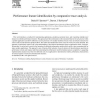244 search results - page 23 / 49 » Modeling Instrumental Conditioning - The Behavioral Regulati... |
115
click to vote
KBSE
1997
IEEE
15 years 4 months ago
1997
IEEE
Given a program S and a precondition Q, the strongest postcondition, denoted sp(S Q), is defined as the strongest condition that holds after the execution of S, given that S term...
110
Voted
ICST
2008
IEEE
15 years 7 months ago
2008
IEEE
It is becoming increasingly important to be able to adapt an application’s behavior at run time in response to changing requirements and environmental conditions. Adaptive progr...
ECAL
2003
Springer
15 years 5 months ago
2003
Springer
An agent-based approach is used to explain the formation of vortex swarms in biological systems. The dynamics of the multiagent system is described by 3N coupled equations, modeli...
FGCS
2006
15 years 19 days ago
2006
This work introduces a method for instrumenting applications, producing execution traces, and visualizing multiple trace instances to identify performance features. The approach p...
212
Voted
BPM
2011
Springer
14 years 18 days ago
2011
Springer
Compliance to legal regulations, internal policies, or best practices is becoming a more and more important aspect in business processes management. Compliance requirements are usu...

